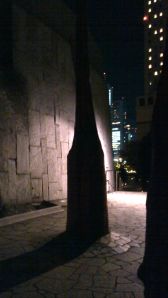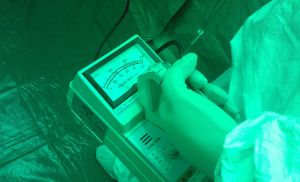“Kein Licht II”, performed in November 2012 during Festival/Tokyo, was adapted from one of the two texts written by Elfriede Jelinek in response to the nuclear disaster that happened in Fukushima. Director Takayama Akira, founder of the theatrical unit Port B, has taken on the task of staging this play.
The performance was conceived as a “tour” through places in Fukushima, whose landscape has been reconstructed in various locations in the Shinbashi area of Tokyo. Leaving the comfortable audience seats behind, the “spectators” of this work embark on the tour individually and follow exact indications, in order to move from one location to another. Amidst the setting created in each location, the participants listen to fragments of Jelinek’s play through a portable radio that they each carries.
The fact that the landscape recreated here is faithful to the original one in Fukushima is proven by the images on the postcards that contain the route indications. The particular characteristics of photography as an artistic medium best highlights the harsh reality of the contaminated area, namely that time has stopped there and that it has become a deserted place. Where there were people just moments ago, there is no one anymore now. Each setting conveys the desolation brought on by the unexpected catastrophe. At the same time, every location suggests the presence of an invisible element that keeps people away from their homes and workplaces, from schools and playgrounds. In this context, the use of the radio is also a subtle allusion to radiation. However, the meaning of the radio is taken one step further in this performance, for it also suggests that there are things that remain unseen and unheard, unless you adjust yourself to the right frequency.
The act of transposing Fukushima onto Tokyo, 226 km away from the Fukushima Daiichi Nuclear power plant, is in itself provocative, taking a critical stance towards any discourse about Fukushima held while maintaining a distance from the place. It is that very distance that Takayama Akira’s concept argues with.
The dramatic text itself is brought to life through the voices of high school students from Fukushima. Conceived as a long discourse of mourning, it pleads the fact that the price we have to pay for using light is just too big. There is anger, repentance and forlornness behind every line, but what surprises the listener most is the sound of the phrases. As if the catastrophe had affected not only people and environment, but also the language itself, the words of “Kein Licht II” have a disconcerting sharpness to them.
By articulating aspects that the Japanese phrase would rather level out or hide under a veil of ambiguity out of a well-meant consideration for the listener, the translation has chosen to keep the structure of the original German text and, together with it, the particular atmosphere of a language that is by its nature more appropriate for expressing critical stances. Transposing the discourse imagined by Jelinek into natural-sounding Japanese would have meant making the discourse milder, with all the sharp points erased out. But at least when denouncing the aftermath of the Fukushima accident, an incisive – even though outlandish – discourse seems to be the right choice.
With all the linguistic and structural particularities of the text, the task of weaving it into the tour performance concept is all the more remarkable. The result is one that is highly experiential for the audience. First of all, the very existence of the spectator is a condition sine qua non for the development of the performance. By sharing information concerning the performance with the production staff, by moving from one location to another and by observing each setting in its own context,the members of the audience become participants in their own right in the creation of this work.
Secondly, the spectator witnesses the transfiguration of Shinbashi. There is actually a reason why this particular area in Tokyo was chosen for the staging of Fukushima; it is revealed within the very first location and it is one of the most thought-provoking aspects of the performance. Nonetheless, the sudden transformation of the once familiar setting is a thrilling experience. You are given the occasion to step into places in the neighborhood you would probably never enter otherwise. On your way from one location to another you might meet other participants, whom you recognize by the radios and the postcards they are carrying. You might exchange knowing smiles with them at the thought that you are sharing the same experience, unknown to the passers-by, who might only find your actions somewhat suspicious.
The Port B tour performances, such as “Kein Licht II”, are are highly conceptual works, rooted in our most urgent reality , designed to make audience rethink their everyday surroundings. In a crisis situation the place you think you know like the palm of your hand becomes a foreign, dangerous place. I can only wish that everybody would experience this as theatre, in the Port B version, and not in reality.
More on Festival/ Tokyo 2012 “Kein Licht II” in this excellent article by William Andrews on Tokyo Stages.
*Update: Since September 12th through October 5th Port B’s latest project “Evakuieren” takes place in the Rhein-Main region in Germany. (Images here and German language info available here) For those who are in the area, it is certainly worth experiencing.
(* This article has first appeared on the “Blog Camp in F/T” platform, a Festival/Tokyo 2012 program for young critics lead by performing arts journalist Iwaki Kyoko, and was reblogged with permission.)


